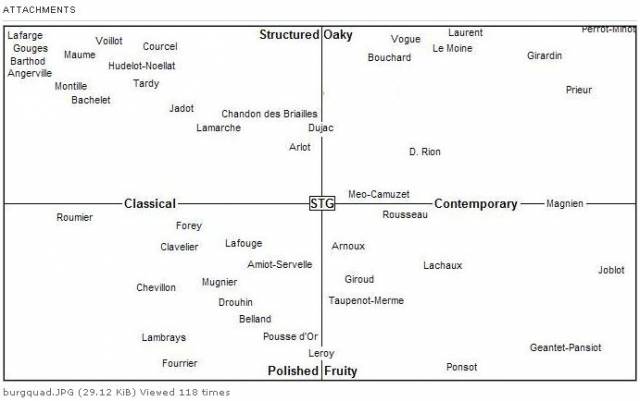By popular demand

By popular demand

Hi Henry,
Very interesting, but whose tastes/impressions does this chart represent?
‘Oaky’ speaks for itself, but a polarity between Classical and Contemporary begs some descriptive criteria for fitting those labels. And ‘Polished’ is surely a goal of the best producers, like Rousseau and Dujac…
So many questions…
Nigel
Hi Nigel,
I can’t remember where I first saw this, but requests pop up for it now and then. It is, of course, not my invention, and the characterizations should be tempered by one’s own experiences and preferences.
In other words, somebody went to the trouble to do this, and thanks to them for their opinions.
I don´t get it completely … but apart from this:
why are Arnoux and Lachaux so far apart ? ![]()
Also I think Ponsot is very misplaced.
Yes, surprised about the Dujac and Rousseau, but, imho, got Geantet-Pansiot completely right. One of the few burgs that can easily be mistaken for Cali pinot (not that there is anything wrong with the latter–but not what I am looking for in Burg).
Quite interesting although obviously quite arbitrary and opened to challenge.
I thought Lachaux’s son had dialled down the oak.
This was on the squires bb at least 5 years ago and probably pre-dates that by a few years too. Hence, the separate locations for Arnoux and lachaux and other locations that people might find odd today.
Thank you for sharing this, Henry!
Drew,
You are indeed welcome!
Everyone who likes Burg can quibble, but that’s the fun bit.
I think it was either created by Paul Wasserman or based on his chacterizations - but as they were about ten years ago. So not reflective of current winemaking styles.
Arnoux-Lachaux is one property, former Domaine Robert Arnoux … in 2007 Pascal Lachaux, wine-maker there for 12+ years, added his name officially to the designation.
(there´s never been a Domaine Lachaux … as far as I´m concerned)
This was mine and and it is indeed from a very old thread. While I don’t see too many things that jump out at me in a “what the hell was I thinking?” kind of way, it was more of a parlor game than anything else just to feed some chatter on the thread and I really hope nobody’s treating it as anything authoritative. There are a few names I’d shuffle around and plenty I could add.
There was no Arnoux-Lachaux at this time. There was Domaine Robert Arnoux and the Pascal Lachaux negociant wines which were made in a purposely younger-drinking style, hence their different placement.
I imagine some of the questions people are posing here were discussed on the original thread.
The idea behind this was to clarify two kinds of style variations within the more customarily used style variations of classic and modern. E.g., some of the classic producers (like Gouges) were called classic because of their structured, backwards style, and yet you also had producers (like Mugnier) that were called classic with essentially an opposite style, silky and open-knit in youth. By the same token you had modernists that were all about the “capture the fruit” style, ripe but still very pure on the fruit, others where it was about letting the toasty barrels do their thing. The thing that gave me the biggest chuckle was making Perrot-Minot literally off the charts in the oaky category but I don’t think anyone ever picked up on the humor…
Agreed. It should be more towards the polished side with a little structure.
I’d still put Ponsot right about where it is.
This is cool and thought provoking. But I am a little confused by the analysis (not the placement of producers but the framework itself).
Keith, what are the the x-axis and y-axis intended to define? The x-axis shows a Classic-to-Contemporary continuum, but I’d like to understand more about the basis for that continuum. The y-axis continuum is less clear to me.
Cool exercise and thanks for sharing.
That is really cool. Thanks for sharing.
Where is DRC?
STGT center square.
x is a continuum from classical to modern. Y is a continuum from structured to polished (within classical) and oaky to fruity (within modern). The concept works better on the classic side than the modern side since it’s difficult to chart producers that are both very oaky and very fruity, whereas structure and polish tend to be opposite poles or at least in some tension with each other (of course, structured wines do acquire polish given the proper 20+ years of cellar time). But I’ve changed my thinking somewhat and now tend to regard certain “polished” styles as a form of modernism though not the Parkerization-type modernism captured at this point in time.
Henry, thank you very much for finding and posting this. ![]()
Keith, you did a really fine job with this ten years ago, and I see little to quibble with even today, although the jury is still out at domaines such as Maume and l’Arlot with recent changes there. ![]()